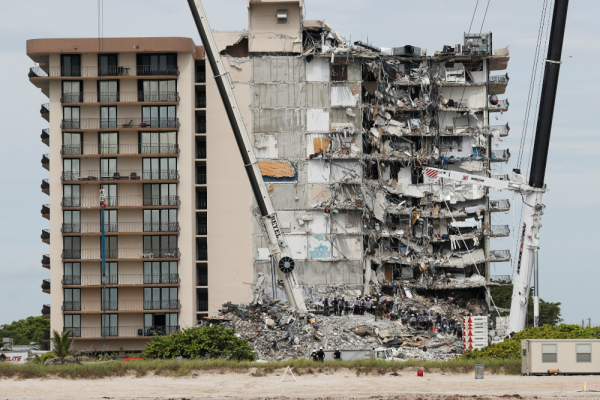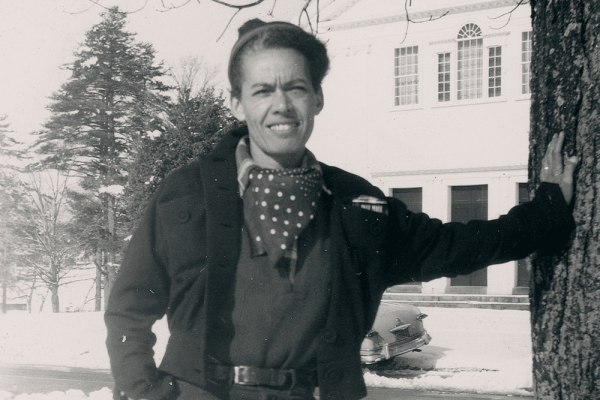Long before the Champlain Towers South in the Florida town of Surfside crumbled, resulting in at least 95 deaths, the buildings were on a shaky foundation. The terrible collapse was not only a failure of physical structures — steel and concrete eroded by natural elements and neglect — but it was also a failure of social structures due to organizational infighting, institutional gridlock, and urban wealth disparities.
If we want to understand this tragedy, we must see more clearly the failure of these physical and social structures that we have built and continue to build. For too long, the Christian imagination has divorced our identities and social worlds from geography, as if we exist in the abstract, apart from the land and the built environment we inhabit. But what if who we are — and especially who we are together — is completely dependent on the everyday spaces we inhabit, like high-rise condos and retirement communities?
Surfside, Fla., is a small, beachside town north of Miami Beach, Fla., comprised primarily of residential properties, with dozens of luxurious condo buildings and hotels overlooking the Atlantic. For many, life in Surfside fulfills their long-awaited retirement dreams. A life of working and saving (or inheriting wealth) may be rewarded with sunrises over the ocean and relaxing days by the pool, but this reward is not without its costs, both morally and materially: The price of real estate on the beach is largely inaccessible unless you’re wealthy (according to Redfin, the average cost of a home in Surfside is almost $800,000).
Just blocks away from where the Champlain Towers South collapsed, urban Miami tells a tale of two cities, as immigrants and working-class communities struggle to survive while gleaming high-rises cater to the celebrities of South Beach and the economic elite. These glaring divides are a reality in many U.S. cities, with Miami being one of the most notorious. One 2019 report found the Miami metro area was home to over 30 billionaires, yet had “the ninth highest rate of poverty among large metros across the nation,” including rates that were “most pronounced” among Black and Latinx populations. The Miami Herald noted that the county where Surfside is located “has the second-biggest gap in the nation between the haves and the have-nots,” surpassed only by New York City.
In a way, even Surfside’s idyllic oceanfront was not insulated from these kinds of disparities, as older properties like the Champlain Towers South had fallen into disrepair for decades, burdening residents with astronomical maintenance fees.
The condo board knew there were issues with the building, but units continued to sell and appreciate as gentrification-driven prices of surrounding properties soared up over 33 percent in the last year alone, based on Redfin estimates. Tragically, the homeowners association struggled to decide how to tackle the estimated $15 million worth of repairs that the building needed. Neighbors and residents split into factions and turned on each other, locking the whole community into a process of struggle over who would secure their properties’ future and at what cost.
By the time the association had begun to fully appraise the situation with Champlain Towers South, it was too late. The warning signs were there for years: growing cracks in the physical foundation and bigger stressors on the social connections that also helped maintain the building. As workers now sort through the rubble of this latest U.S. tragedy, how will we reflect on its meaning for us? How can our mourning move us to honor the lives lost by avoiding the physical and social collapses that made the one in Surfside possible?
Willie James Jennings, in his landmark book The Christian Imagination: Theology and the Origins of Race, suggests that much of our contemporary situation is plagued by a “diseased social imagination.” One of the main symptoms of this disease is our disconnectedness from each other and place, and the subsequent fragmentation of society. Divisions and polarization due to race, class, and gender are exacerbated by the divide-and-conquer world of real estate and the colonial impulses underneath society’s power structures.
In the midst of inequalities and social conflicts that collapse buildings, what do Christians believe and practice about community and belonging? Jennings helps us to see that in order for Christian belonging to be realized in the physical world, we must first understand how our lives together have been warped by the twisted logics of race and real estate, and historic hierarchies deeply entrenched in our social structures, neighborhoods, and churches.
Only when we are able to grapple with this reality will we be able to face with courage the possibility of Christian belonging that reflects the truly radical nature of Christ’s body in the world. What might a Christian ethic of “retirement” look like in a highly polarized economy where older adults cluster together with others like them, often struggling with high costs of living, if they can even retire at all? Thinking through a question like this will help us avoid future building collapses and push us to imagine new ways of relating and belonging to each other.
It’s a deficit of Christian imagination that presumes these status quo urban economics are simply the way things are — or worse, the way God intends them. As entire communities teeter on the brink of collapse, will we wait until it’s too late to address the cracks in our social foundation, or can we move toward repairing physical streets and buildings in ways that help everyone to flourish?
The work of reimagining our society always begins in a particular community. This is as true in the local congregation as it is in local politics. Christian communities must see the church not as a social club laid over the existing logics of real estate, but instead as a creatively disruptive people whose lives are joined with one another and God in a beautiful mess of belonging. In this way, the church exists in the world as a demonstration and signpost of what is possible when people see their lives as intimately and inextricably linked to others, especially those that society has deemed other.
I cannot imagine the collective pain and loss of the families whose loved ones were taken so suddenly in this tragedy, even as I take small comfort in knowing that God draws near to those who suffer. There’s no quick solution to the cracks in our buildings or the fraying of social fabric that wears thin in the context of urban inequality.
We need to deeply invest in affordable housing, community development, infrastructure planning, and redistributive economics, none of which is for the faint of heart. Yet I remain hopeful that something beyond the inevitability of collapse is still possible in our cities. Perhaps that seed of belonging is rehearsed every week in Christian communities around the table — a body taken, blessed, broken, and given for the life of the world.
Got something to say about what you're reading? We value your feedback!







